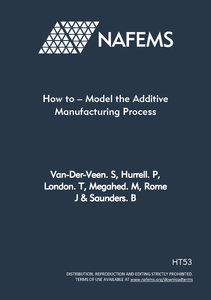
Over the last decade the Additive Manufacturing process has attracted a high level of interest due to the potential that the process has to revolutionise the way engineering companies design products. As well as offering rapid cycle times from initial concept to finished product it also allows previously unmanufacturable designs to be produced. However, even with AM, it is not possible to just “print” any shape out of metal. Distortion and cracking are recurring issues. Process simulation has a key role to play in resolving these issues and optimising the process parameters.
This document provides guidance for people wanting to predict residual stress and distortion of metal additive manufactured parts using a physics-based numerical simulation of the manufacturing process.
It is relevant for processes in which metal is cooled down from a molten state or a very high temperature, such as Powder Bed Fusion and Directed Energy Deposition. Although much has already been written about this family of processes and their simulation, this text contains some pragmatic guidance needed to obtain good results for everyday industrial use. For example, what to pay attention to when selecting a simulation software if you need to predict build stressinduced part buckling? What time-step to impose on a simulation intended to accurately predict cooling rates?
Contents
| 1 | Why simulate? | 1 |
| 2 | How to simulate? | 3 |
| 3.1 | Thermo-mechanical simulation | 3 |
| 2.2 | Inherent strain based simulation | 3 |
| 3 | Thermo-mechanical simulation method | 5 |
| 3.1 | Heat-source model | 5 |
| 3.2 | Spatial discretisation and aggregation of layers | 7 |
| 3.3 | Element activation or birth and temporal discretisation | 9 |
| 3.4 | Risk of inducing errors / factors that most strongly influence precision | 12 |
| 3.5 | Model set up time | 21 |
| 3.6 | Simulation time | 22 |
| 3.7 | Outputs and words of warning | 24 |
| 4 | Inherent strain simulation method | 27 |
| 4.1 | Variants of the inherent strain approach | 27 |
| 4.2 | Spatial discretisation and layer aggregation | 28 |
| 4.3 | Temporal discretisation for inherent strain simulation | 30 |
| 4.4 | Inherent strain identification | 31 |
| 4.5 | Material properties for inherent strain analyses | 33 |
| 4.6 | Risk of inducing errors / opportunity of improving accuracy | 33 |
| 4.7 | Risk of missing certain failure modes and counter-distortion | 33 |
| 4.8 | Model set up time | 34 |
| 4.9 | Simulation time | 35 |
| 4.1 | Outputs and words of warning | 36 |
| 5 | References | 37 |
| 6 | Acronyms | 43 |



